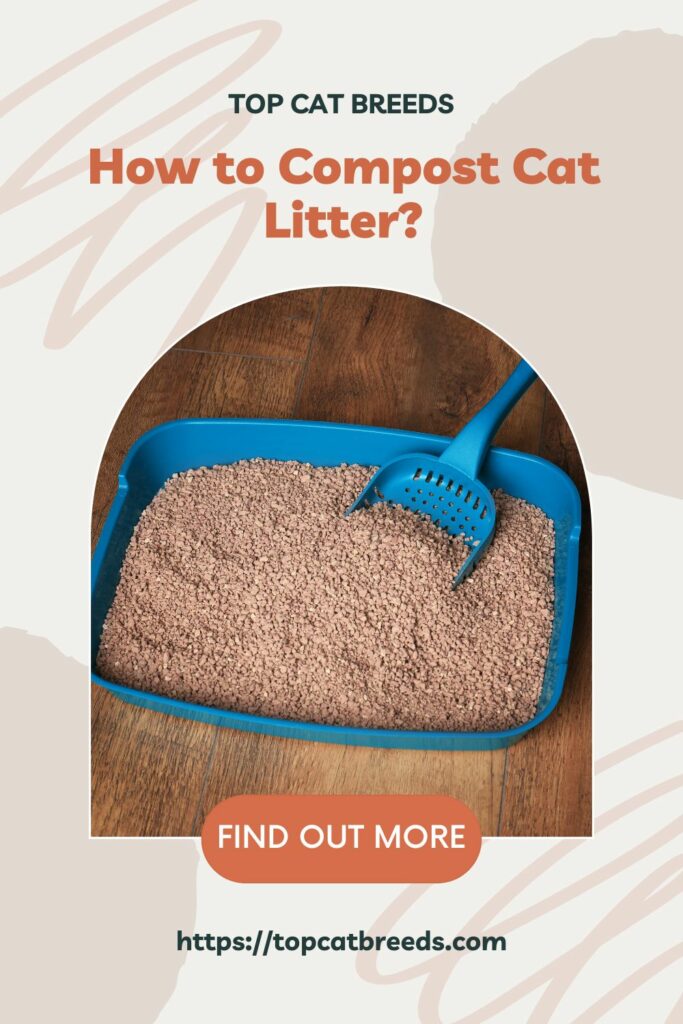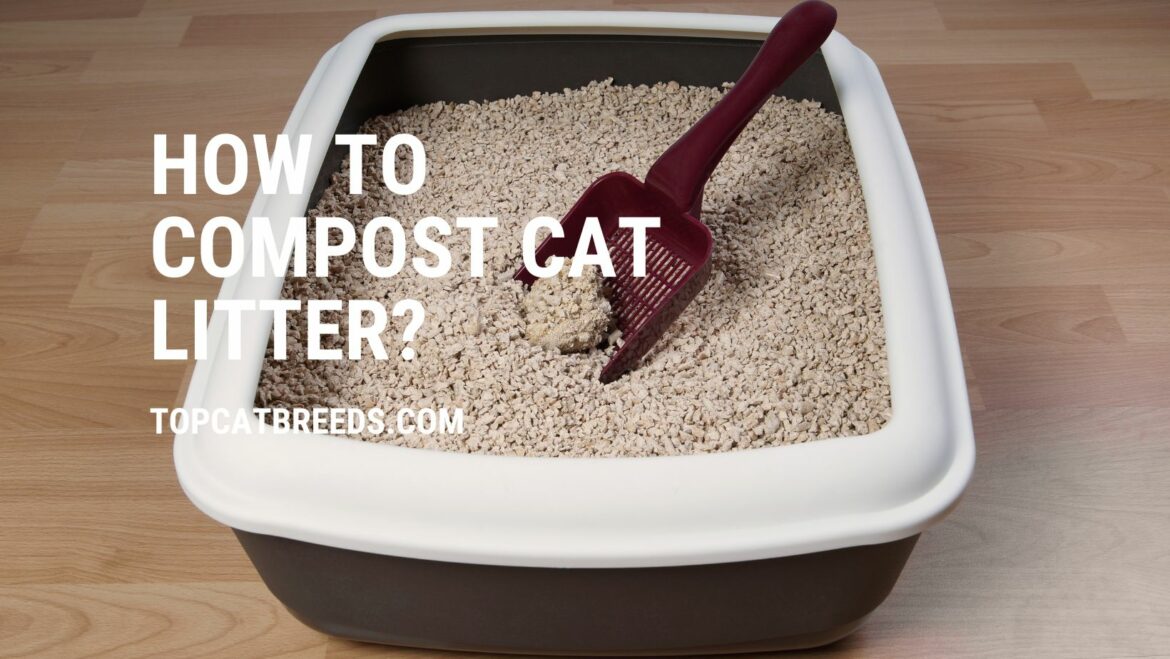By composting cat litter, you can keep the biodegradable material out of your garbage while turning it into something useful. However, before initiating the process, there are some things to remember.
Ask any cat-lover what they dislike about owning a cat, and their answer usually includes litter. Cats are generally adorable, but handling their waste is not amusing.
Since you cannot flush cat litter, it usually ends up in your garbage. This is why you must use a more eco-friendly method of handling cat litter.
Some cat litter can be composted. This method is eco-friendly and can help reduce the amount of garbage in landfills. It also creates a rich soil amendment. But how to compost cat litter?

How To Properly Compost a Cat Litter Step by Step?
Like traditional composting, the process of composting involves using the same materials. The base layer of the compost pile is composed of green and brown materials, while the cat waste and litter go on top.
After you have made your initial layers, you can add more of the compost. However, keep in mind that you can only add so much of the green and brown materials at a time. Instead of throwing them in the bin whenever you need to, try to save them until your entire allotment.
This method will help improve the effectiveness of your compost by keeping the materials in an airtight container. Brown materials can also be stored in a dry location. For cat waste, keep it inside a separate container.
Important Reminder
Before mixing the compost pile, you must continue adding it to it for several months. Doing so helps in aerating it, which is very important for the breakdown process. After you have turned and mixed the pile, continue adding as you would typically do. Make sure to add the cat waste layer at the top.
1. Creating a Compost Pile
Creating a compost pile is not tricky, and it can be done either with a homemade bin or a store-bought one. The method is similar whether you use a homemade or store-bought one. Aside from pet waste, the compost pile can also be used to nourish other organic materials, such as food scraps.
2. Prepare a Compost Pile Base made From Course Materials
The compost pile’s base layer comprises various materials, such as sticks, vegetables, and corn cobs. This layer helps maintain the moisture and airflow throughout the compost, which is necessary for the natural decomposition of the materials.
3. Create a Layer of Green and Brown Composting Materials
The bottom layer of the compost pile should contain brown materials, such as dried fruits and vegetables, grass clippings, and wood. On the other hand, it should contain green materials, such as food waste, grass clippings, coffee grounds, and fresh green leaves. Continue adding both the green and brown layers.
4. Put The Cat Litter
The cat litter and waste are the last layers of the compost pile. You can add a layer of brown waste on top of the cat waste, though this is unnecessary. This will help break down the remaining cat waste faster.
Can Anyone Compost The Litter of Cats?
Although it is generally considered that anyone can compost cat litter, it is important to note that not all types of litter can be turned into compost. Also, keep in mind that there are potential health hazards associated with this practice.
Although it is relatively easy to start composting cat poop, it can be intimidating at first. This is why it’s vital to start with the soiled litter first. Once you are cozy with the process, you can start adding the old waste to the composting pile.
Are There Different Types of Cat Litter?
Best materials for composting cat litter include wheat, corn, recycled paper, and anything made from plants, such as tofu varieties. These are easy to break down and similar to the dry leaves you can add to your compost.
However, before composting your cat litter, ensure it is fully biodegradable. This includes paper, wood, corn, wheat, coconut husk, and other natural litter products.
Read also: 5 Best Cat Litters for Multiple Cats at Home
Can They be Composted?
Certain types of litter are not allowed to be used in compost. These include those made up of sand, clay, and fragrances, as well as those clumping. Generally, one cannot compost litters that contain crystal, clay, or odors.
If you are unsure if the litter is sustainable, it is best to avoid adding it to your compost bin.
So, Composting the Litter of Cat is not For Anyone?
Although composting is considered the most eco-friendly way to throw away litter, not everyone is a fan of it. For instance, while it is an excellent alternative to throwing away cat waste, getting started can take a lot of effort.
Besides keeping safety in mind, you must also deal with cat poop. This can be handled directly, or it can be stored inside an airtight container. You can keep it inside the container until it is time to put it in the compost pile.
One of the most discouraging factors that you should consider when it comes to composting is the fact that it involves your cat’s litter. But, once you get accustomed to it, you will start to dump dog poop in the bin.
Is Composting a Cat Litter Safe For People Around?
Although it is naturally safe composting cat litter, there are things you should consider before doing so. For instance, it is crucial to keep in mind that dog and cat poop can contain parasites and bacteria.
If you are not careful, your compost might end up with parasites that can cause illness. For instance, if you have cat feces, it can carry the parasite Toxoplasma gondii. This illness is caused by a parasite found in improperly cooked meat. It can affect pregnant women and people with weak immune systems.
This is why it is important to follow all safety rules when keeping cat litter in a safe environment. This can help prevent the spread of harmful organisms such as Toxoplasma gondii .
How Can You Compost Cat Litter Properly?
Like other organic waste, cat litter is also composted. It is placed in a bin or a composter, which allows it to break down naturally over time. However, this method can take up to a year.
During this time, you will be required to mix the various components of the compost pile regularly to maintain its natural state. This process will help nourish the soil and improve its overall health. It can also help you create a variety of flower beds and gardens that are filled with nutrients.
Are There Things To Consider When Composting Cat Litter?
Now you know how to compost cat litter, before starting, you must have a ready-made compost pile. Although building a large compost pile in an apartment is possible, it can take up a lot of space. Instead, you can use a kitchen composter like Lomi.
Even if you are not a huge fan of composting, Lomi can help you keep the process simple and effective by making nutrient-rich dirt in your own home. This device is a kitchen appliance that anyone can use.
When it comes to handling cat waste, gloves are required. Even though you are not touching the material with your bare hands, rubber gloves will keep you protected from fungal and bacterial infections. Washing your hands thoroughly will also prevent the spread of parasites and bacteria.
Can You Use the Composted Cat Litter in your Garden?
In addition to your flower beds and garden, cat litter can also be used in various areas of the yard, such as your ornamental plants. However, remember that you should not place the new litter in the vegetable gardens. Instead, add it slowly to the compost pile.
This method will also help break down the cat litter and dilute it even more. This is beneficial for the safety of the composted materials.
Conclusion
Knowing how to compost cat litter and getting started with it is relatively easy and can help the environment in many ways. However, before you start, you must know what types of litter you can safely compost. With the help of your Lomi kitchen composter, you can start creating nutrient-rich soil.

